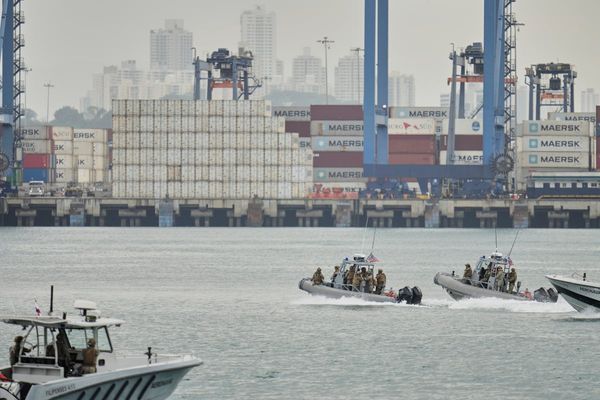It was in 1986 that the dictator Ferdinand Marcos and his family were forced to leave the Philippines in disgrace. Helicopters airlifted the family from the Malacañang Palace, as protesters filled the streets. Marcos Sr, after ruling with an iron fist for 20 years, had been toppled by a popular uprising, the People Power Revolution.
Crowds stormed the abandoned palace, discovering the extent of the family’s opulence. There were grand artworks, boxes of commemorative gold coins, lavish jewellery, hundreds of gowns, dresses, and, infamously, an enormous collection of designer shoes belonging to the former first lady, Imelda Marcos.
Analysts say that, ever since the family was ousted, it has been intent on forging a comeback. In the documentary The Kingmaker, Imelda Marcos described it as her son’s destiny to become the president. Now he is on the cusp of doing so.
Ferdinand Marcos Jr, “known as Bongbong”, was educated in the Philippines and at a boarding school in England. An extract from Marcos Sr’s diary suggests the family was concerned his son lacked the “character” needed for the future. “Bongbong is our principal worry. He is too carefree and lazy,” he writes, adding later: “I have told him that since we have enemies, he will have to fight the battles I fought in the past against myself and against circumstance.”
Marcos Jr began studying politics, philosophy and economics at Oxford, but, according to the university, did not complete a degree course and was awarded a special diploma in social sciences. Marcos insists he graduated with the equivalent of a degree.
After university, Marcos Jr became the vice-governor of his home province, Ilocos Norte, on the north-western tip of Luzon, at the age of 23 and later governor. He was 29 when his father was ousted and the family was forced to leave the Philippines.
Marcos Sr died in exile in 1989. However, the family was allowed to return to the country in the 1990s. Marcos Jr then began to re-establish his political career, again becoming governor in Ilocos Norte, the family’s stronghold, a congressman and a senator. In 2016, he ran for vice-president but lost to Leni Robredo – an outcome he unsuccessfully challenged in court. Robredo lost to him in the 2022 presidential race.
(November 8, 1949) Political debut
The Manila trial lawyer Ferdinand Marcos wins the first of what would be three terms in the House of Representatives.
The win comes a decade after he was jailed for the 1935 assassination of his father's political rival, Julio Nalundasan. He was later acquitted after arguing his own case in a supreme court appeal.
Marcos is elected to the Senate in 1959 and eventually becomes Senate president, a position seen as a stepping stone to the presidency. The following are the key dates in the political rise, fall and resurrection of the clan, as Ferdinand Marcos Jr prepares to move back into the presidential palace where he grew up.
(May 1, 1954) Marriage
After a whirlwind courtship, Marcos marries beauty queen Imelda Romualdez.
His bride is from a powerful political dynasty in the central province of Leyte and will eventually help him rule the country for 20 years.
Imelda, who has a taste for expensive jewellery, art and shoes, serves at various times as a cabinet member, governor of the national capital region, and ambassador at large.
They have three children, including a son called Ferdinand Marcos Jr, who they nickname 'Bongbong'.
(November 9, 1965) Presidency
Marcos switches parties to run against the incumbent president, Diosdado Macapagal, in the 1965 elections. He wins in a landslide. He is re-elected to an unprecedented second term in 1969 but allegations of corruption and authoritarianism have already started to cloud his reputation.
(September 21, 1972) Martial law
Constitutionally barred from running for a third term as president, Marcos shocks the nation by imposing martial law on 21 September 1972, which enables him to stay in power.
He uses the outbreak of armed hostilities against communist and Muslim insurgencies as justification for the decision.
With US backing, Marcos rules by decree and launches a brutal crackdown on dissent that results in tens of thousands of people being jailed, tortured or killed.
(January 17, 1981) Martial law ends
Marcos lifts martial law but continues to rule by decree with his martial law-era acts and orders remaining in place.
(June 16, 1981) Election boycott
The first presidential polls since 1969 are boycotted by the opposition. Marcos easily wins in a vote widely derided as a sham.
(August 21, 1983) Aquino Jr killed
The prominent opposition leader Benigno Aquino Jr is assassinated by state forces at Manila airport as he returns from exile in the US, triggering massive street protests calling for the dictator's resignation.
(November 3, 1985) Snap election
Widely rumoured to be ailing and reeling from international criticism, Marcos announces on US television that he will call a snap presidential election for the following year. Corazon Aquino, the widow of the assassinated opposition leader Benigno Aquino Jr, reluctantly takes up the challenge of running against him.
(February 7, 1986) Fraudulent vote
Marcos declares himself the winner of the February presidential election, which a delegation of international observers and the Philippines' Catholic bishops say was marred by allegations of wholesale fraud and violence. Aquino rejects the outcome and calls for massive civil disobedience actions.
(February 22, 1986) People Power
The defence secretary, Juan Ponce Enrile, and the paramilitary Philippine cnstabulary chief, Fidel Ramos, announce they are breaking from Marcos. Marcos claims to have foiled a coup attempt. Catholic church leaders muster hundreds of thousands of civilians on to the streets to protect the rebels, sparking the People Power Revolution.
(February 25, 1986) Marcoses flee
After a four-day standoff and the US government's decision to withdraw its backing, Marcos and his family flee the Malacañang presidential palace.
The vast complex, which has been their home for 20 years, is ransacked by protesters who find thousands of shoes, designer dresses and documentary evidence of their extravagance.
The US military flies the family to Hawaii and Aquino takes over the presidency. Her first action is to create an agency to go after the estimated $10bn plundered by Marcos, Imelda and their allies.
(September 28, 1989) Marcos dies
Marcos succumbs to kidney, lung and heart ailments, dying in exile in the US. Four years later, his remains are flown to the family's stronghold of Ilocos Norte province and temporarily stored in an air-conditioned crypt at their ancestral home in Batac city.
(November 4, 1991) Family comeback
Imelda Marcos returns to the Philippines to face charges of tax fraud and corruption. The court cases drag on for decades and no one in the family is jailed. Tapping local loyalties, the clan regains its political clout in successive elections. Marcos Jr wins his father's old congressional seat in 1992 and is later elected Ilocos Norte governor. He enters the Senate in 2010.
(May 9, 2016) Narrow loss
Marcos Jr narrowly loses the vice-presidential contest to congressional newcomer Leni Robredo, who he accuses of cheating. He challenges the result but the supreme court upholds it.
(November 18, 2016) Marcos Sr burial
Marcos Sr's remains are buried at the national heroes' cemetery in Manila with full military honours on the orders of President Rodrigo Duterte, an ally of the family. The private ceremony is attended by relatives, as police are deployed to stop angry protesters from going near the site.
(October 5, 2021) Presidential bid
Marcos Jr files his candidacy for the presidency and forms a formidable alliance with Duterte's daughter Sara, who runs for vice-president. He surges to the top of voter surveys as efforts to have him disqualified from the race crumble and a massive misinformation campaign seeking to rewrite the family's history cranks into high gear.
(May 9, 2022) Election day
Marcos Jr caps his family's return to political power by winning the Philippines presidency. He secures more than double the tally of nearest rival Robredo. Agence France-Presse
Marcos is married to the lawyer Louise Araneta-Marcos, known as Liza, with whom he has three sons. The eldest, Ferdinand Alexander Marcos III, known as Sandro, is running for the first district congressional seat of Ilocos Norte, and has developed a prominent social media presence where he is received adoringly by young female supporters.
The family continues to face numerous court cases over their plundered wealth, which is estimated to be as high as $10bn. Imelda is appealing against a 2018 criminal conviction on seven corruption charges.
Marcos Jr has been unapologetic about his family’s past and has downplayed or denied abuses under his father’s rule. He praised his father as a “political genius”, and his mother as the dynasty’s “supreme politician” during a recent interview with CNN Philippines.
Under martial law, which was imposed by Marcos in 1972, thousands of Marcos critics were arrested, tortured and killed.
Marcos Jr’s camp, and its supporters, have portrayed the Marcos years as a time when the country was thriving and prosperous. Online misinformation about the era has inundated social media, prompting media groups and academics to form factchecking initiatives.
Marcos Jr’s appeal has relied on nostalgia relating to his father’s rule, say analysts. “He did not inherit the political savvy or the appeal or the charm of the father,” said Prof Maria Ela L Atienza, who teaches political science at the University of the Philippines. “He’s basically living off or campaigning on the basis of the name of the father.”
His campaign, which carried the slogan “together we shall rise again”, promised unity and a return to what he has portrayed to be a former greatness. He has also pledged to prioritise jobs and lower the cost of living, including bringing down the cost of rice, though critics say such proposals are lacking in detail.
His opponents fear the return of the family to power could lead to the reversal of democratic gains made in the country since his father was toppled in 1986.







